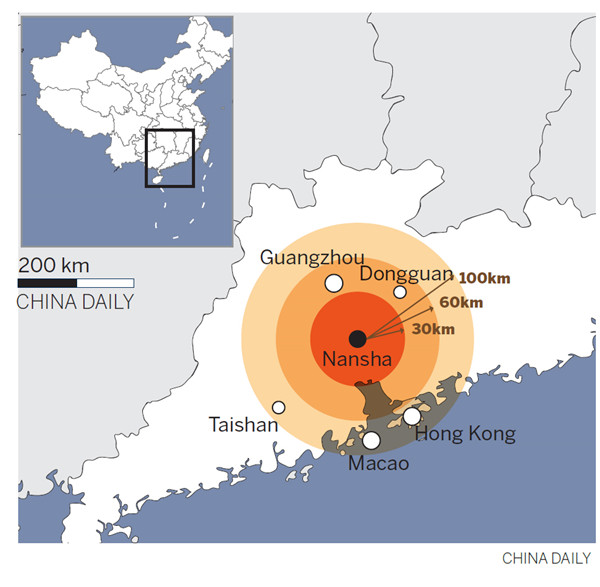It is the very place where the ever-running Pearl River joins the vastness of the South China Sea, symbolizing the area's ever-growing horizons.
Located at the Pearl River estuary, Nansha is well-known for its rich marine resources. This fertile land has survived the ups and downs of time, and is the silent witness of every major historical event taking place in at the Southern Gate of China. Through Nansha, a major stop along the ancient Maritime Silk Road, oriental civilization was spread widely to the rest of the world.
With a distance of 38 nautical miles from Hong Kong and 41 nautical miles from Macao respectively, and serving as the connection point of the A-shaped city clusters on the banks of the Pearl River estuary, Nansha dominates the geometric center of the greater Pearl River Delta region. The traditional agriculture civilization has helped shape the its Lingnan-style water village scenery characterized by green banana trees and fragrant lotus flowers; while it is the modern industrial civilizationindustry that enables Nansha to stand atin the forefront todayof time.

Time flies and transformations ing changes have taken place in Nansha.
At the beginning of the 21st century, thanks to the reform and opening of China and the economic boom of the greater Pearl River Delta region, Nansha has witnessed one after anotherhas made one impressive achievement after another. Within a radius of 100 kilometers surroundinof g Nansha, there are five major international airports and 11 modern cities including Guangzhou, Shenzhen, Hong Kong and Macao. There are over 100 quay berths and China's largest Ro-Ro terminal at the Nansha Port, which consolidates Guangzhou Port's position as one of the top 10 ports in the world with an annual container handling capacity of more than 11 million containerTEUs. At present, a port-related manufacturing industrial cluster, featuring automotivebile, ship building and nuclear power equipment, has taken shape in Nansha.
A number of state-level scientific and technological innovation platforms, such as the HKUST Fok Ying Tung Graduate School and Guangzhou institutes of China Academy of Science, have been established in Nansha. Emerging industries are rapidly agglomerating in heregathering in the area, including a number of strategic new industries, such as big data, 3-D printing and smart robots, as well as financial leasing, cross-border e-commerce and mobile Internet. A development pattern characterized by port-related logistics and manufacturing has beguins to take shape, and Nansha, as a new city featuring the integration of port, industry and urban functions, is on the rise.
In 2012, with the approval by the State Council, Nansha became China's third state-level new zone established in economic powerhouse regions after Shanghai Pudong New Zone and Tianjin Binhai New Zone. In 2014, the State Council further approved the establishment of the China (Guangdong) Pilot Free Trade Zone, listing Nansha as a core area for the pilot free trade zone. Nansha will focus on developing shipping logistics, finance, and international commerce and as well as advanced manufacturing industries. Moreover, a modern industrial base which is led by a manufacturinge-related service industry, as well as a world-class hub of comprehensive services will be established in Nansha. By doing so, the pPilot zZone will comprehensively enhance the transformation and development of the Pearl River Delta region and play an important role in creating an open economy for the entire country.
In early 2015, during his inspection tour to Nansha, Premier Li Keqiang urged Nansha to carry forward the pioneering spirit and setting a good example for the rest parts of the country.
